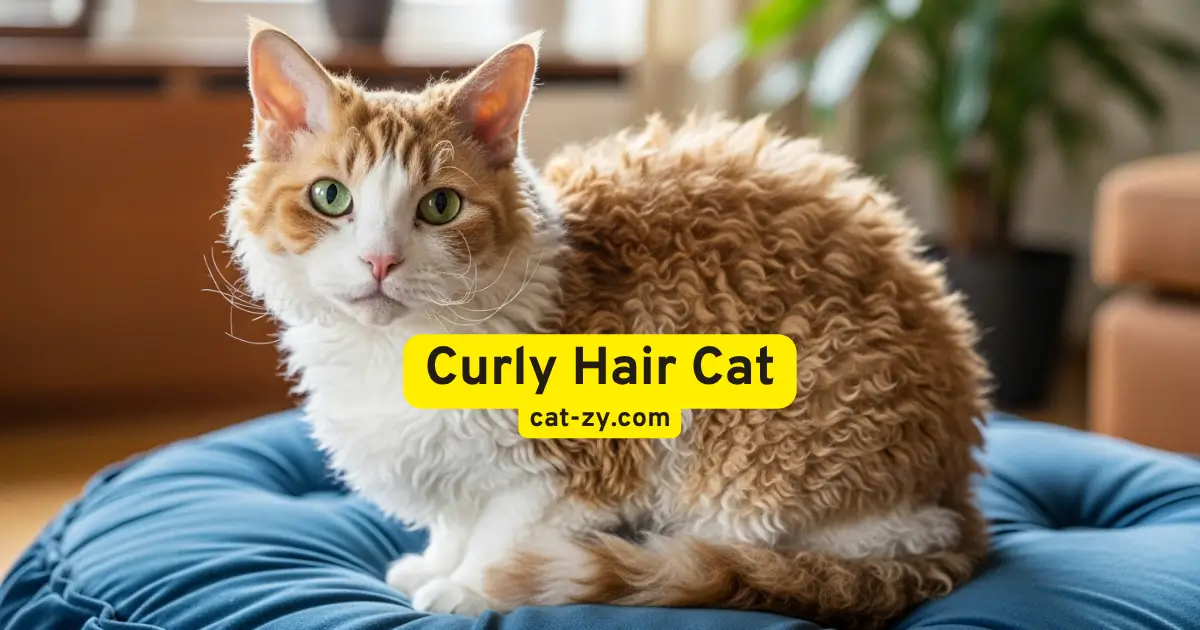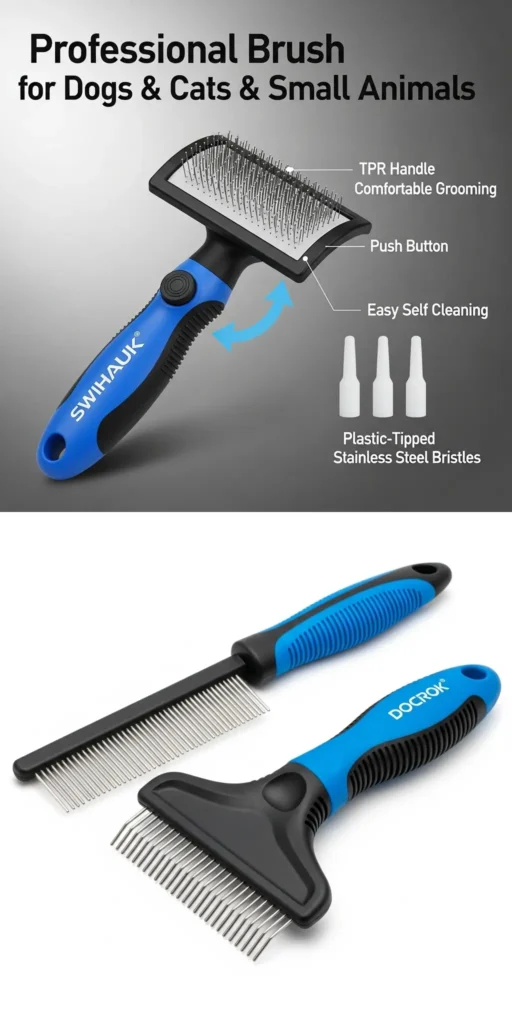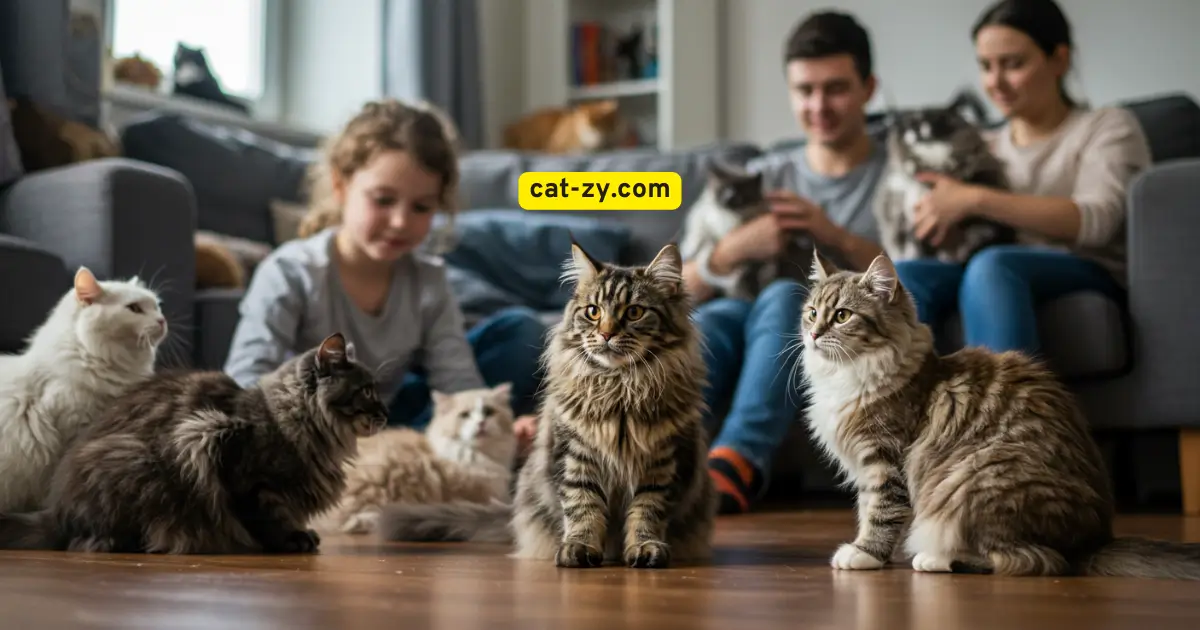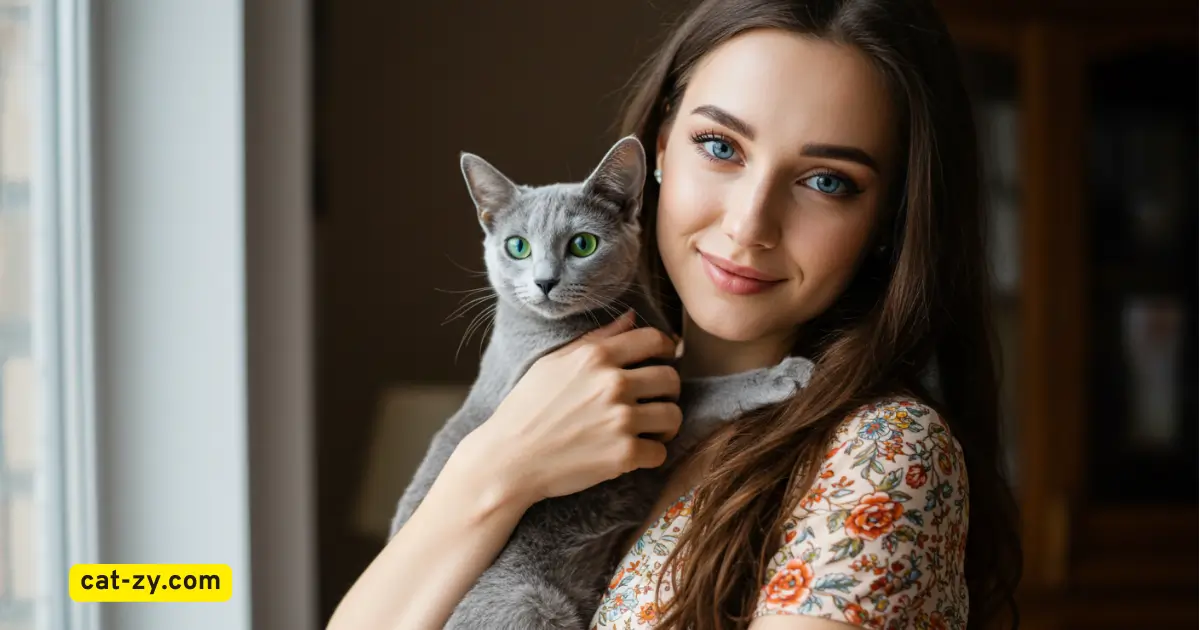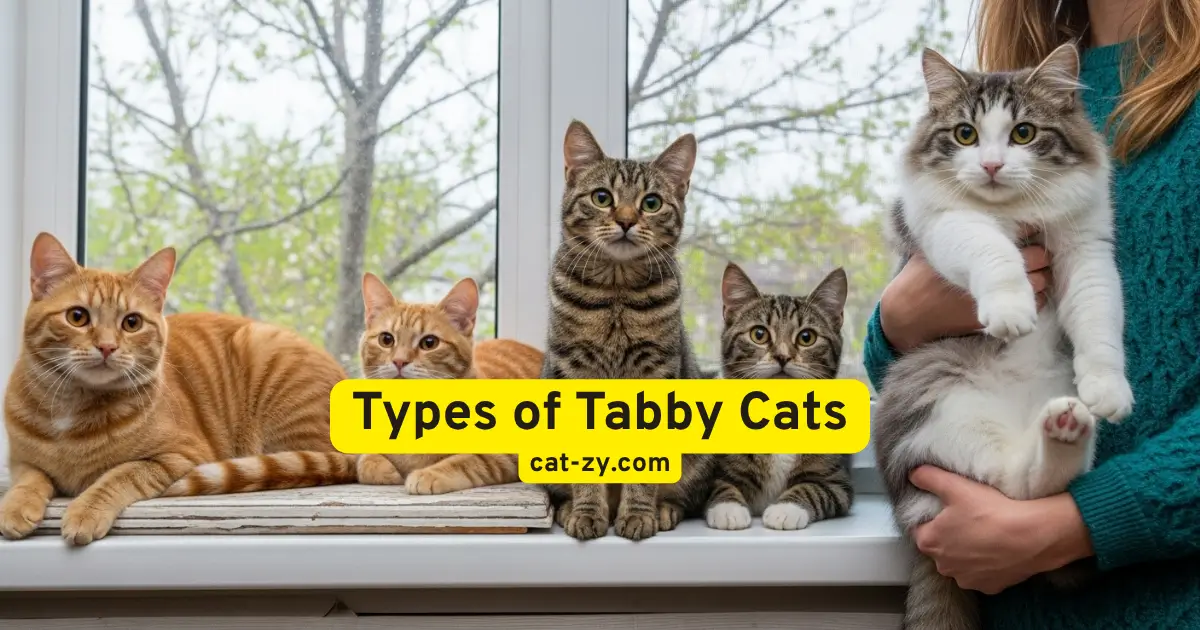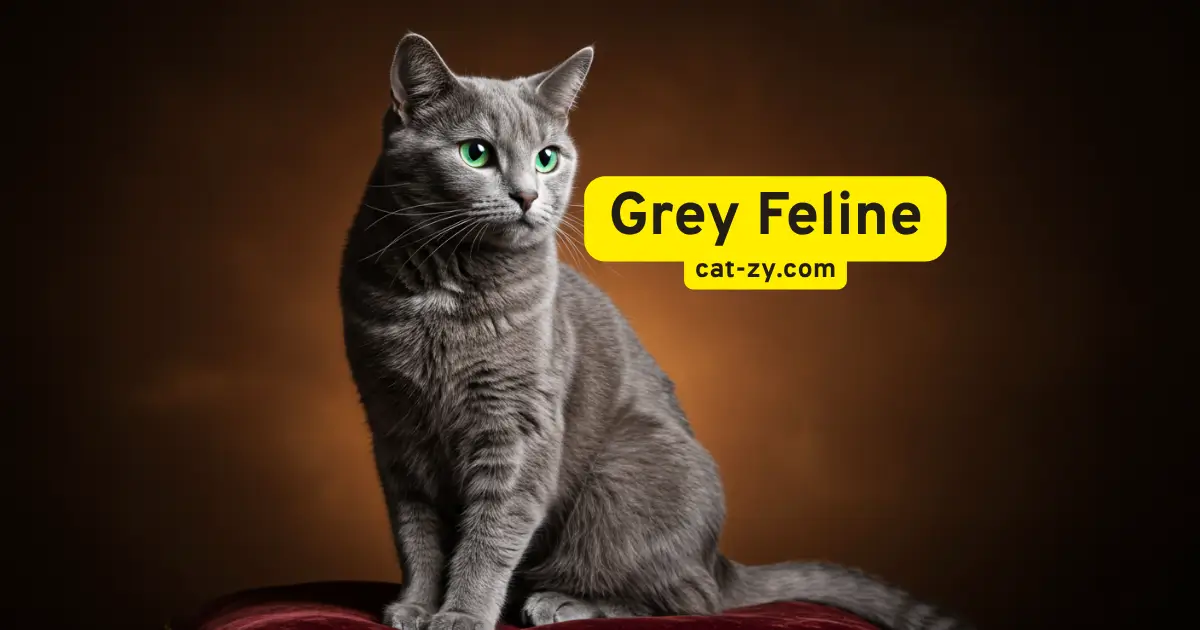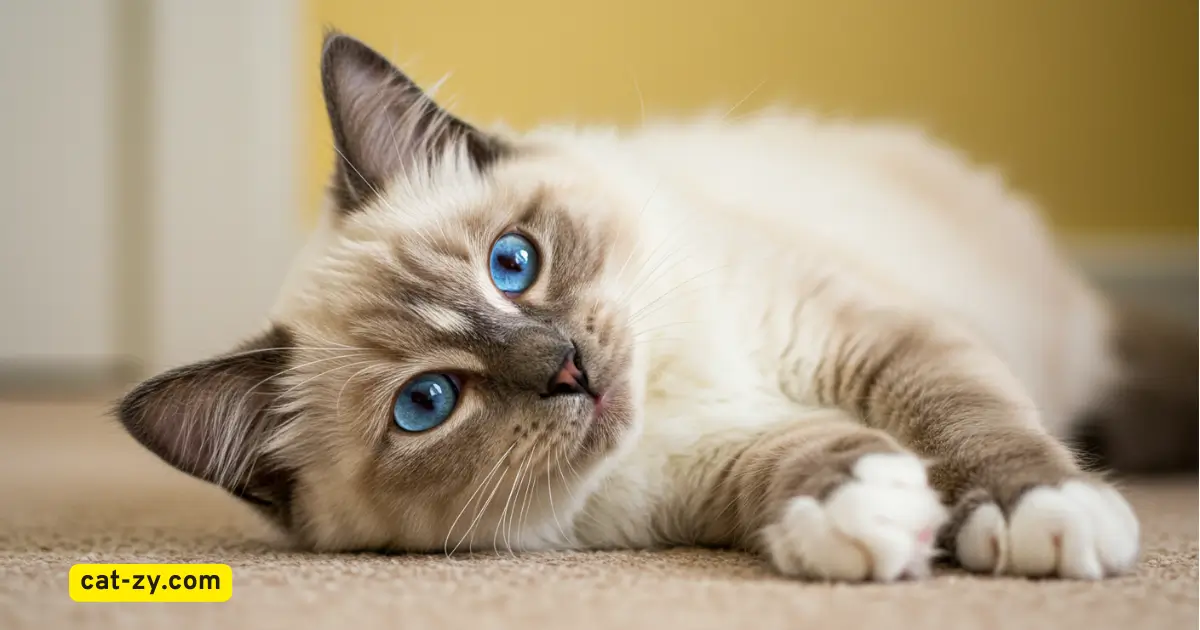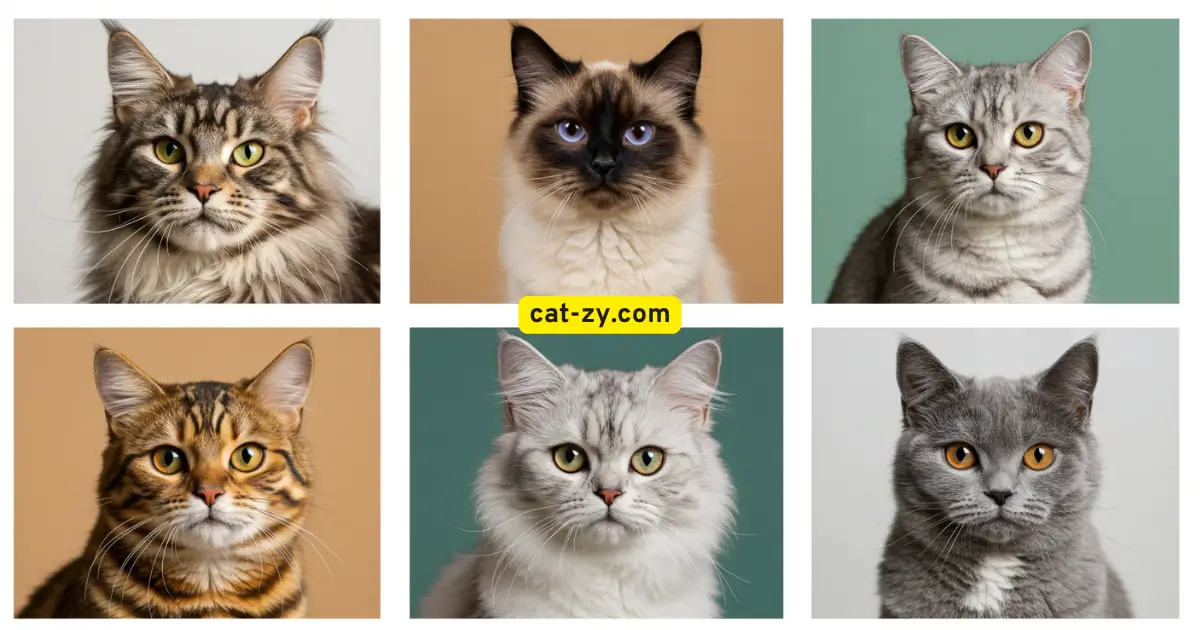Curly Hair Cat: 7 Stunning Breeds You’ll Instantly Love
Do you want to discover the most enchanting feline companions? If you’re looking for a unique companion, consider a curly-haired cat breed. These cats are not only beautiful but also have charming personalities.
They have distinctive coats and a playful nature. It’s no wonder that many people love these breeds. In this article, we’ll introduce you to 7 stunning curly-haired cat breeds that will make you go “awww.” Whether you’re a seasoned cat owner or new to felines, you’ll find their charm irresistible.
Table of Contents
The Fascinating World of Curly Hair Cats
The world of curly hair cats is both fascinating and diverse. It offers a range of breeds that will capture the heart of any cat lover. These cats are known for their striking looks, engaging personalities, and special traits.
Curly hair cats have their unique coats due to a natural mutation. This mutation changes the structure of their fur, leading to different textures. Their curly fur makes them stand out among other cats.
The Science Behind Curly Fur
The science behind curly fur in cats is all about genetics. A genetic mutation causes their fur to curl or wave. Understanding this can help us appreciate their uniqueness. Research has shown how genetics influence their coat texture.
The Selkirk Rex breed is a great example. It has a dominant gene for curly fur. This gene makes its coat plush and curly, showing the genetic factors at work.
Curly Cats and Allergies: What You Should Know
Many think curly-haired cats are hypoallergenic. But, it’s important to know no cat is completely hypoallergenic. The main allergen is a protein in cat dander and saliva, not the fur.
Curly cats might shed less, which could mean less allergen in the air. If you have allergies and want a curly hair cat, spend time with one first. This experience will guide your decision-making process.
Selkirk Rex: The Teddy Bear of Cat Breeds
The Selkirk Rex is known as the “teddy bear” of cat breeds. It has a curly coat that makes it stand out. This makes it different from other domestic cats.
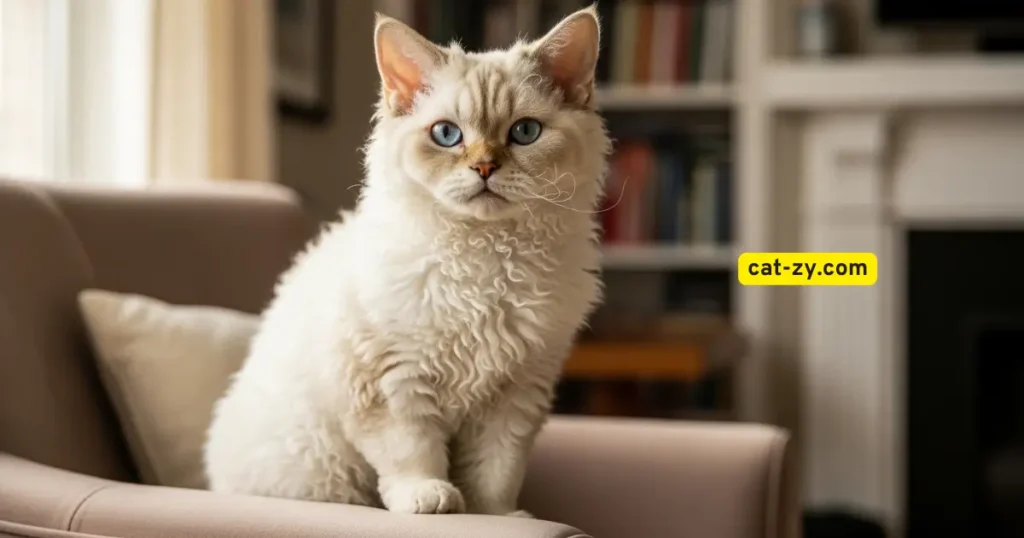
Origin and Fascinating History
The Selkirk Rex breed originated in America during the late 1980s. Miss DePesto, the original Selkirk Rex cat, was discovered in Montana. Her distinctive curly fur resulted from a genetic mutation.
Her appearance captivated breeders who began developing the breed. They named it after the Selkirk Mountains. This name captures the breed’s rugged yet lovable nature.
Physical Characteristics and Coat Types
The Selkirk Rex has a plush, curly coat. It can be short or long. Their fur is soft and dense, needing regular grooming to avoid mats.
Colors and Patterns
Selkirk Rex cats have many colors and patterns. They can be solid, tabby, tortoiseshell, or pointed. Their coat colors include white, black, and various shades of red, blue, and cream.
Body Structure and Features
The Selkirk Rex has a sturdy body structure. They have a broad face and a short, slightly curved nose. Their ears are medium-sized, and their eyes are large and expressive.
Temperament and Personality Traits
Selkirk Rex cats are gentle and affectionate. They love to be around people and are very social. Their relaxed nature makes them excellent companions for households with children or multiple pets.
Overall, the Selkirk Rex represents an affectionate and flexible breed. Their unique look and charming personality make them a favorite among cat lovers.
Devon Rex: The Pixie-Eared Curly Wonder
The Devon Rex distinguishes itself through its curly coat and elf-like ears. This breed features a lean physique, spirited personality, and distinctive appearance.
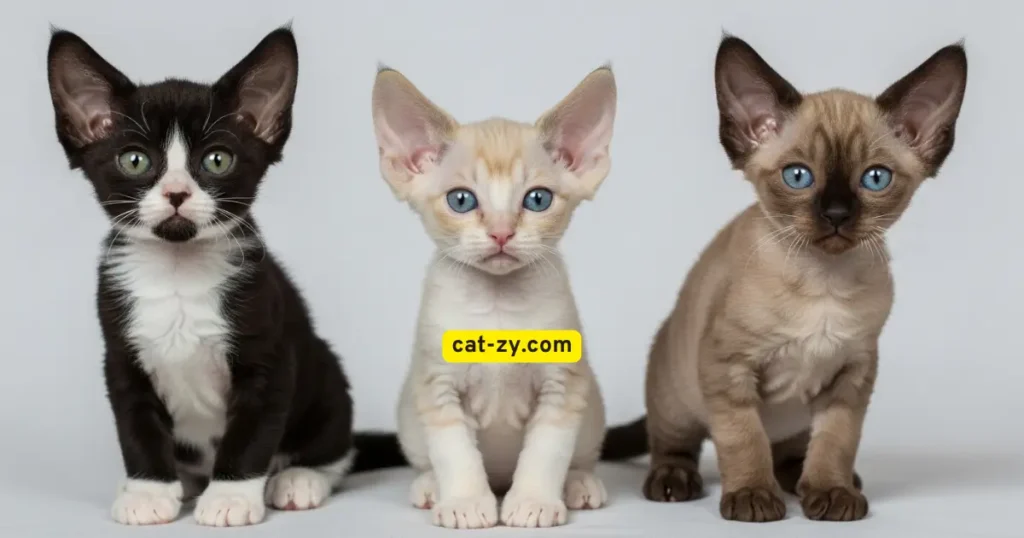
Origin and Development of the Breed
The Devon Rex emerged from Devon, England, during the 1960s. It was created from a natural mutation that made its coat curly. Kirlee, a male cat discovered in a barn, became the first Devon Rex.
Kirlee’s remarkable coat fascinated breeders, who then focused on developing the breed.
Distinctive Physical Features
The Devon Rex has a curly coat that’s soft and wavy. Its coat comes in many colors and patterns, making each cat special.
The Unique Devon Coat
The Devon Rex’s coat is very distinctive. Its curls are loose and wavy, giving it a soft, textured look.
Facial Structure and Ears
The Devon Rex features a narrow face with prominent, widely spaced ears. These ears make it look like a pixie. These characteristics significantly contribute to the breed’s appeal.
Playful Personality and Social Nature
The Devon Rex is playful and social, loving to interact. They’re smart and curious, making them fun to be around. For those seeking an amusing feline companion, the Devon Rex is ideal.
Cornish Rex: The Elegant Curly Coat
The Cornish Rex is a standout among curly hair cats with its wavy fur. It’s not just beautiful but also has a rich history and a lively personality.
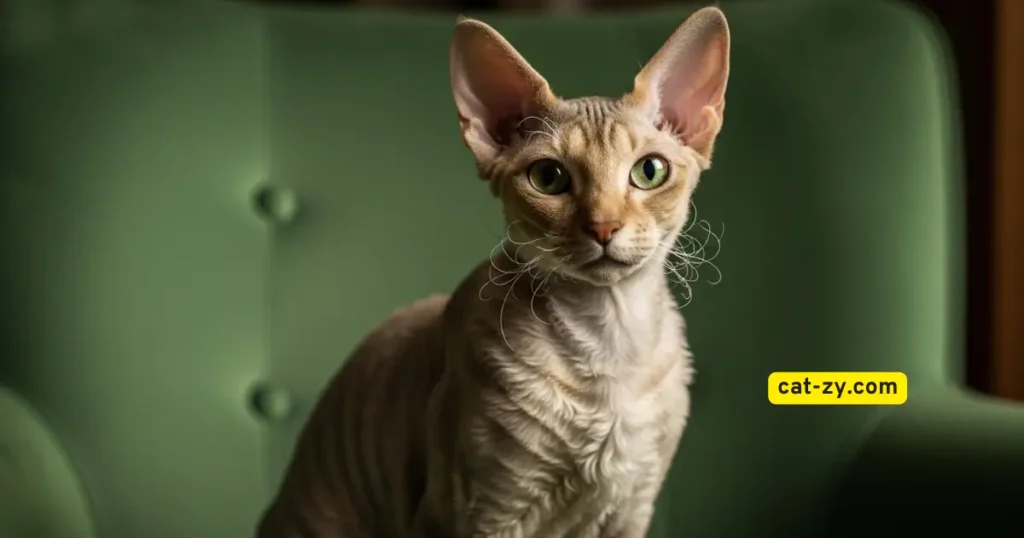
History and Development
The Cornish Rex originated in Cornwall, England, during the 1950s. Kallibunker, a male cat discovered on a farm, was the breed’s foundation. His curly coat was a natural mutation. This fascination led breeders to establish the Cornish Rex breed.
Distinctive Physical Attributes
The Cornish Rex has a slender body and big ears, making it look unique. Its most striking feature is its coat.
The Wavy Coat Texture
The Cornish Rex has a soft, wavy coat unlike any other. It feels like suede or silk, making it a pleasure to touch.
Slender Body and Large Ears
They have a slender, athletic build and oversized ears. These features add to their elegant look, setting them apart from other curly fur cats.
Energetic Temperament and Intelligence
Cornish Rex cats are full of high energy and intelligence. They are playful, curious, and love to be around people. This makes them perfect for families or anyone who wants an active pet.
In short, the Cornish Rex is a fascinating breed that combines beauty, smarts, and fun. For anyone considering a curly hair cat, the Cornish Rex merits serious consideration.
LaPerm: The Natural Curly Hair Cat Phenomenon
The LaPerm is a standout among curly haired cat breeds. It’s known for its unique fur. The breed’s history begins with a genetic mutation that created its curly coat.
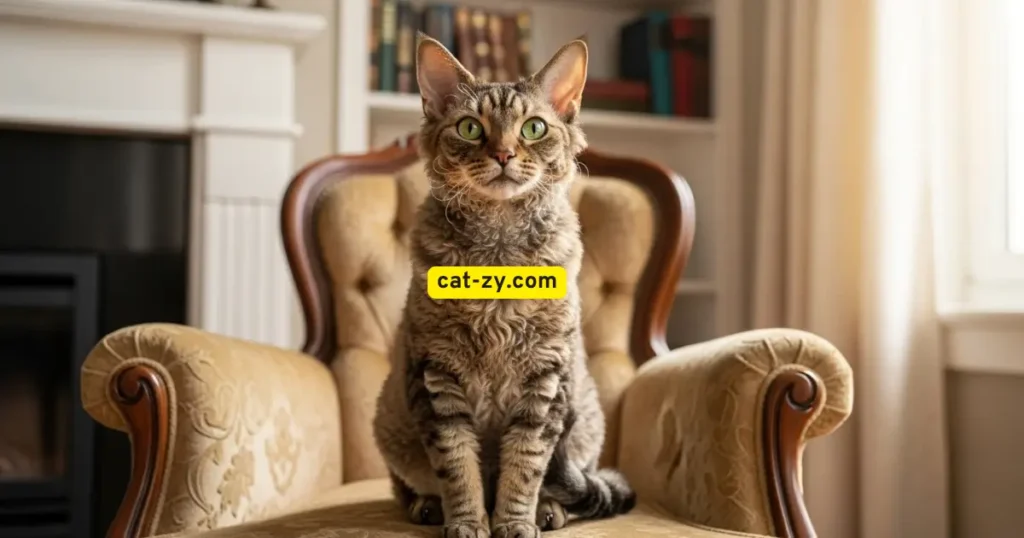
Spontaneous Mutation and Breed Development
A genetic mutation in the 1980s Oregon gave the LaPerm its distinctive curly coat. This change caught the attention of breeders. They were drawn to the cat’s looks and friendly nature.
Through breeding, the LaPerm has grown into a strong breed. It now has different coat types and colors, all with curls. This has made the breed more than just a pet; it’s a cherished companion.
Varied Coat Types and Appearances
The LaPerm’s coat is one of its most striking features. It can have long or short curly coats. This variety appeals to many different tastes.
Long vs. Short Curly Coats
LaPerm cats display both long and short coat variations. Both show off the breed’s curls. The long-haired LaPerm has a more dramatic look, while the short-haired version is more compact.
Color Variations and Patterns
LaPerm cats come in many colors and patterns. They can be solid, tabby, or tortoiseshell. This variety makes each LaPerm special.
Affectionate Nature and Family Compatibility
The LaPerm is loved for its friendly nature. These cats bond strongly with their families. They love to be around people and join in family activities.
They get along well with families, including kids. With the right socialization, LaPerm cats can adapt to many homes. They bring happiness and companionship to their owners.
American Wirehair: The Springy-Coated American Treasure
The American Wirehair is a special cat with a springy coat and a charming personality. It’s different from other curly-haired cats like the Selkirk Rex. Its unique wire-like coat makes it stand out.
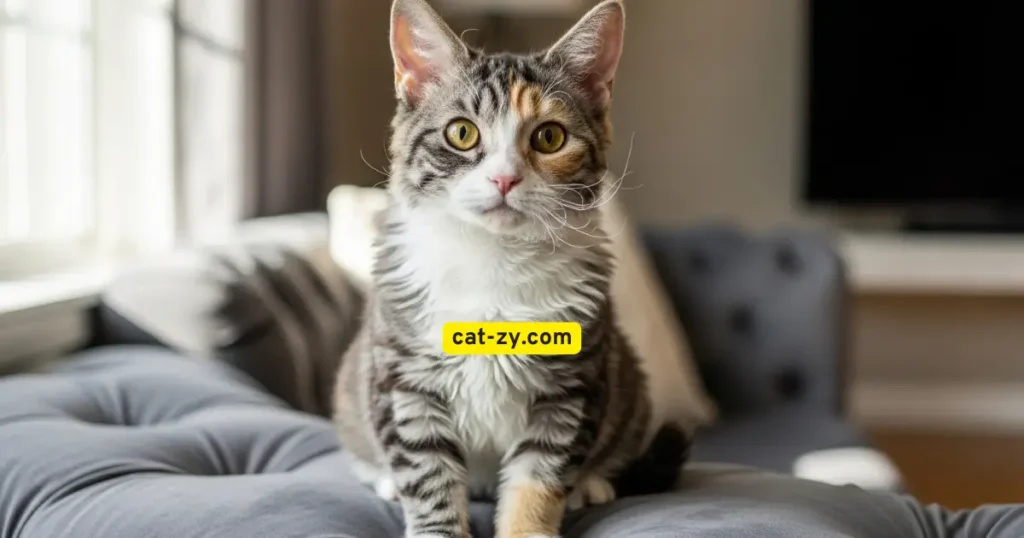
All-American Origin Story
The American Wirehair came from the United States, in New York, in the 1960s. A farm cat had a special mutation that started this breed. Breeders worked to keep the wire-like fur texture.
Unique Wire-Like Coat Texture
The American Wirehair’s coat is its most striking feature. The hairs are crimped, making the coat feel rugged and springy.
Crimped Whiskers and Eyebrows
Not just the coat, but the American Wirehair’s whiskers and eyebrows are also crimped. This adds to their unique look. It’s a key part of their charm.
Coat Density and Feel
The coat’s density can vary, but it’s usually resilient and springy. It feels nice to touch. Grooming frequency varies based on coat thickness and individual grooming behaviors.
Balanced Temperament and Adaptability
American Wirehairs have a balanced temperament. They’re adaptable, friendly, and get along well with kids and other pets. They’re a great fit for many families.
They’re not just pretty; they also have a wonderful personality. They make great companions for those who love curly fur cats.
Ural Rex: The Rare Russian Beauty
The Ural Rex is a rare cat breed from Russia, famous for its curly fur. It stands out with its unique look and loving nature.
Russian Origins and Limited Recognition
The Ural Rex comes from Russia, where it was first found. It’s not well-known outside Russia, making it rare. People are working hard to show it to more people, but it’s hard to get noticed.
Distinctive Coat and Physical Features
The Ural Rex has a curly haired coat that’s soft and special. Its looks are as interesting as its fur.
Unique Wave Pattern
The Ural Rex’s coat has a unique wave pattern. This makes each cat look different.
Body Structure and Size
Ural Rex cats are medium-sized and strong. They look sturdy but can move quickly.
Gentle Disposition and Family Compatibility
Despite its exotic look, the Ural Rex is very gentle. It loves families and is usually friendly with kids.
German Rex: The Velvet-Like European Gem
The German Rex is a mesmerizing breed with a unique, velvety coat. This breed boasts deep European roots and a unique temperament. Its physical characteristics are also noteworthy.
European Heritage and Development
The German Rex comes from Europe, discovered in the mid-20th century. It has a curly coat due to a natural mutation. Through breeding, its unique traits were preserved.
Plush Coat and Physical Characteristics
The German Rex is famous for its soft, plush coat. It feels like velvet. This coat is not only beautiful but also has a special texture.
Texture Differences from Other Rex Breeds
The German Rex differs from other Rex breeds with its thicker, more luxurious coat. This makes it very appealing to a pet.
Facial Features and Body Type
German Rex cats display sturdy musculature and spherical head shapes. It has large ears and expressive eyes. These features make it a charming companion.
Social Nature and Interactive Personality
Beyond their beauty, German Rex cats are remarkably sociable. It loves human interaction and family activities. It’s affectionate and playful, making it great for families or individuals.
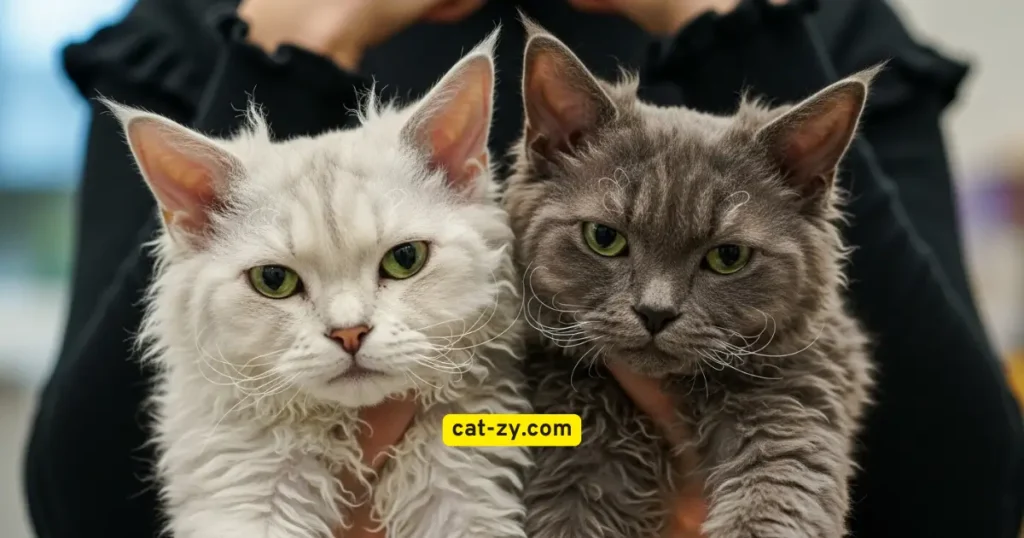
Living With a Curly Hair Cat: Care Guide
Bringing a curly haired cat into your home can be a joy. But you must know their special needs. These cats add a unique charm to any space. To keep them happy and healthy, you need to give them the right care and a good environment.
Specialized Grooming Techniques
Grooming is key for your curly haired cat. Regular brushing helps avoid mats and tangles, important for breeds like the Selkirk Rex and Devon Rex. Use a soft, wide-toothed comb or a slicker brush made for curly coats. Bathing should be rare, as too much can dry out their coat and cause irritation.
Health Considerations for Rex Breeds
Curly haired cats are usually healthy, but they can face some health issues. For example, some Rex breeds might get hypertrophic cardiomyopathy, a heart problem. It’s important to take them to the vet regularly to check their health and catch any problems early.
Creating the Ideal Environment
It’s vital to make a safe and comfy space for your curly haired cat. Maintain moderate temperatures throughout your living space.
Temperature Sensitivity
These cats don’t like extreme temperatures. Provide warmth during colder months and cooling during warmer seasons. Also, give them a cozy, safe place to rest.
By following these care tips, you can make sure your curly haired cat is happy and healthy. They need special care, but they will be a loving and loyal friend.
Adopting Your Perfect Curly Companion
Starting your journey to find the perfect curly cat involves learning about different breeds. Curly cats, like the Selkirk Rex, are not just cute. They also have special personalities and needs.
Finding Reputable Breeders
Finding a good breeder is key when adopting a curly cat. A good breeder offers health guarantees and shares the cat’s background. They also make sure the cat is friendly. Look for breeders who are part of recognized cat groups and have good reviews.
Rescue Organizations for Special Breeds
Thinking about adopting an adult cat or a mix? Reach out to rescue groups for curly breeds. These groups help find homes for cats in need. They also share info on the cat’s personality and health.
Preparing Your Home for a Curly Cat
Before your new cat arrives, make sure your home is safe. Keep wires out of reach and remove dangerous items. Also, set up a cozy spot for your cat to rest. Curly cats, like the Selkirk Rex, need regular grooming to avoid mats.
Conclusion
Exploring curly hair cats has likely won your heart. You might be captivated by the Selkirk Rex’s soft look or the Devon Rex’s unique ears. There’s a curly fur cat for everyone.
Each breed has its charm. The Cornish Rex has an elegant coat, while the LaPerm has natural curls. The American Wirehair, Ural Rex, and German Rex each offer distinct qualities. Think about grooming, temperament, and how well they fit with your family.
Knowing what each curly hair cat needs helps you choose the right one. With proper care, your new furry friend will bring happiness and companionship to your home.
FAQ
What are the main characteristics of curly hair cat breeds?
Curly hair cat breeds have unique, curly coats. These coats can vary in texture and tightness. They often look very charming and have a distinctive appearance.
Are curly hair cats hypoallergenic?
Some curly hair cat breeds, like the Devon Rex and Cornish Rex, are considered hypoallergenic. This is because they have low-shedding coats. However, individual allergic responses vary considerably. You might react to these breeds, so it’s a good idea to spend time with one before deciding to own it.
How do I groom my curly hair cat?
Grooming a curly hair cat needs gentle care. Use a soft brush or comb made for curly coats. Avoid over-bathing, as it can dry out their skin. Consistent grooming prevents tangles while maintaining coat wellness.
What is the temperament of curly hair cat breeds?
Curly hair cat breeds are often very affectionate, playful, and outgoing. Breeds like the Selkirk Rex and LaPerm are known for being friendly and loving. They make great companions.
Are curly hair cats rare?
Some curly hair cat breeds, like the Ural Rex, are quite rare. Others, such as the Devon Rex, are more common. The rarity of a breed can depend on many factors, including breeding programs and where they are found.
Can curly hair cats have blue eyes?
Yes, some curly hair cat breeds can have blue eyes. The color of a cat’s eyes comes from genetics. Specific breeds show higher tendencies for blue eyes through genetic inheritance.
How do I choose the right curly hair cat breed for me?
When picking a curly hair cat breed, think about your lifestyle, living situation, and what you prefer. Research different breeds to learn about their personalities, grooming needs, and energy levels. This approach ensures you discover your ideal feline companion.

